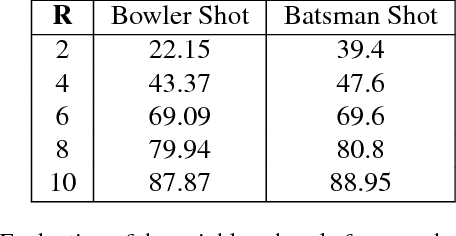Rahul Anand Sharma
Fine-Grain Annotation of Cricket Videos
Sep 27, 2017



Abstract:The recognition of human activities is one of the key problems in video understanding. Action recognition is challenging even for specific categories of videos, such as sports, that contain only a small set of actions. Interestingly, sports videos are accompanied by detailed commentaries available online, which could be used to perform action annotation in a weakly-supervised setting. For the specific case of Cricket videos, we address the challenge of temporal segmentation and annotation of ctions with semantic descriptions. Our solution consists of two stages. In the first stage, the video is segmented into "scenes", by utilizing the scene category information extracted from text-commentary. The second stage consists of classifying video-shots as well as the phrases in the textual description into various categories. The relevant phrases are then suitably mapped to the video-shots. The novel aspect of this work is the fine temporal scale at which semantic information is assigned to the video. As a result of our approach, we enable retrieval of specific actions that last only a few seconds, from several hours of video. This solution yields a large number of labeled exemplars, with no manual effort, that could be used by machine learning algorithms to learn complex actions.
Automated Top View Registration of Broadcast Football Videos
Mar 04, 2017



Abstract:In this paper, we propose a novel method to register football broadcast video frames on the static top view model of the playing surface. The proposed method is fully automatic in contrast to the current state of the art which requires manual initialization of point correspondences between the image and the static model. Automatic registration using existing approaches has been difficult due to the lack of sufficient point correspondences. We investigate an alternate approach exploiting the edge information from the line markings on the field. We formulate the registration problem as a nearest neighbour search over a synthetically generated dictionary of edge map and homography pairs. The synthetic dictionary generation allows us to exhaustively cover a wide variety of camera angles and positions and reduce this problem to a minimal per-frame edge map matching procedure. We show that the per-frame results can be improved in videos using an optimization framework for temporal camera stabilization. We demonstrate the efficacy of our approach by presenting extensive results on a dataset collected from matches of football World Cup 2014.
 Add to Chrome
Add to Chrome Add to Firefox
Add to Firefox Add to Edge
Add to Edge